|
Printables |
PowerPoints |
Online exercises |
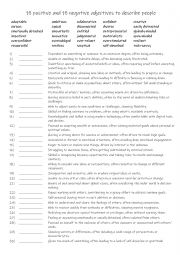
|
B1+-B2 15 positive and 15 negative adjectives to describe character & personality of people people 1
First, students look at the quite challenging 30 adjectives to familiarise themselves with the meanings. Then,they read the definitions and write the corresponding adjectives in the space provided. This worksheet after being checked could be used as a speaking reinforcement activity in pairs or small groups. Answers on page 2.
Level: intermediate
Age: 9-100
Type:
Downloads: 142
|

|
A2+-B1 Practise with present simple, past simple, present perfect, present continuous, future simple & going to 3
Mastering these tenses allows students to describe habits, routines, actions in progress, past events, completed actions, future plans, and intentions. By using them correctly, students can effectively communicate in various real-life situations, such as talking about daily activities, telling stories, making predictions, and expressing plans or de...
Level: elementary
Age: 9-100
Type:
Downloads: 142
|

|
Expressions of preference, desire, or regret I�d rather, I wish, if only & it�s time 3
Students should learn expressions of preference, desire, or regret like "I�d rather," "I wish," "If only," and "It�s time" because they help them communicate personal feelings, make choices, and reflect on past experiences or future possibilities in English. These phrases allow students to express what they want, what they regret, or what they feel...
Level: elementary
Age: 9-100
Type:
Downloads: 142
|
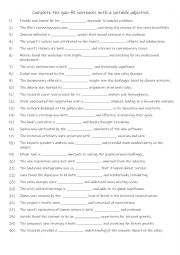
|
C1-C2 Complete the gap-fill sentences with a suitable adjective.
Students read the sentences and complete the gap-fill using a suitable adjective. This worksheet is only suitable for advanced students due to the vocabulary used.However; the teacher could pre-teach the 30 adjectives, then it would be suitable for B2 level students. A speaking reinforcement activity could be used with most of the statements for st...
Level: advanced
Age: 14-100
Type: worksheet
Downloads: 141
|
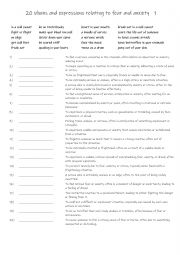
|
B1+-C1 20 idioms and expressions relating to fear and anxiety 1
First, students need to familiarise themselves with the 20 idioms and expressions and their meanings. Then they read the definitions to see which one is being described and write that word in the space provided Answers on page 2.
Level: intermediate
Age: 13-100
Type:
Downloads: 141
|
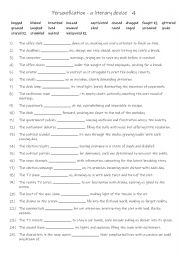
|
B2-C1 Personification - a literary device 4
Learning personification helps students bring their writing to life by giving human qualities to non-human things, making descriptions more engaging and relatable. It enhances creativity, allowing them to craft vivid imagery and evoke emotions in their readers. Understanding personification also deepens their appreciation of literature, as it is a ...
Level: intermediate
Age: 12-100
Type:
Downloads: 141
|
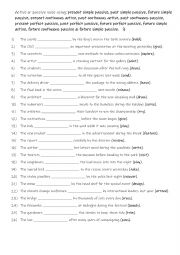
|
B1-C1 Active or passive voice using: present simple passive, past simple passive, future simple passive, present continuous active, past continuous active, past continuous passive, present perfect passive, past perfect passive, future perfect passive, fut
Learning active and passive voice across these tenses enhances students� ability to express ideas flexibly and appropriately. By mastering these structures, students can adapt their language for different purposes, enhancing their overall fluency and effectiveness in both spoken and written communication. Students familiarise themselves with the te...
Level: intermediate
Age: 12-100
Type:
Downloads: 141
|
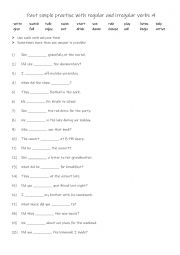
|
Past simple practise with regular and irregular verbs 4
Students first familiarise themselves with the 20 verbs. Then they complete the gap-fill with the correct form of that verb. Answers on page 2.
Level: elementary
Age: 7-100
Type:
Downloads: 141
|

|
B1-B2 Linking words practise -although, but, even though, while, because, since, in spite of, despite, however, so that & in order to
Linking words help connect ideas smoothly within a sentence or between sentences. This makes students writing and speaking more coherent and easier to follow. They clarify relationships between different parts of your text, such as cause and effect, contrast, and addition. This helps your audience understand the logic behind your statements. These ...
Level: intermediate
Age: 10-100
Type:
Downloads: 140
|
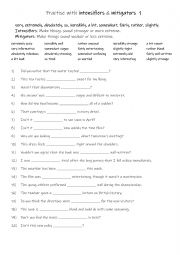
|
B1-B2 Practise with intensifiers & mitigators 1
Students should learn to use intensifiers and mitigators to communicate more precisely, fluently, and naturally. Intensifiers make statements stronger, while mitigators soften them, allowing for nuanced expression of emotions and opinions. Mastering these tools improves writing, speaking, and listening skills, helping students adjust language based...
Level: intermediate
Age: 10-100
Type:
Downloads: 140
|
|
|
|
|












